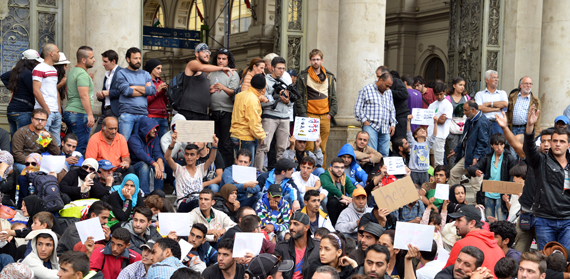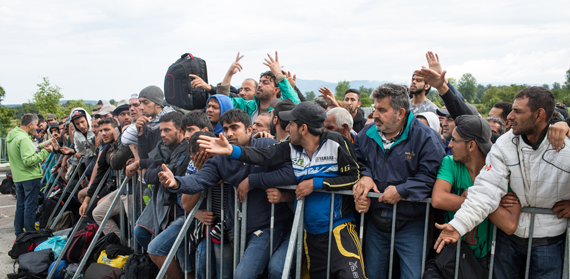Refugees in Budapest back in September, waiting to try and board a train to western Europe.
Guest post by Dr. Simon Goodman, Centre for Research in Psychology, Behaviour and Achievement and Dr. Ala Sirriyeh, Keele University
We are in one of the most intense periods of reporting on issues of refugees. The tragedy in Syria has highlighted the plight of refugees while also showing how world events can have a direct impact on matters in Europe. As a result, 2015 contained a huge amount of coverage of refugees attempting to reach Europe. However, rather than being presented as one continuing event (sadly people had been drowning attempting to reach Europe long before it became a major news story) the movement of people into Europe was presented as a number of different crises.
The first of these was the ‘Mediterranean migrant crisis’ in which ‘immigrants’ were dying attempting to reach Europe. While there was some sympathy for the people dying in this way, and some shock at the extent of the tragedy, this was still presented as a problem of ‘immigrants’ (not refugees) trying to reach Europe. While deaths in the Mediterranean continued, the focus of the ‘crisis’ moved nearer to home with a new emphasis on the people gathering in Calais attempting to reach the UK. This ‘Calais migrant crisis’ emphasised the impact of the movement of people on the UK. Again the focus of the ‘crisis’ were ‘immigrants’ who were presented as unfairly attempting to reach the UK and who posed a threat to the security and economy of the UK. The next ‘crisis’ was known simply as the ‘Migrant crisis’. Here the crisis was presented as both a ‘threat’ to the UK, mainly because of Calais, and more generally to Europe, where a particular threat was to British holidaymakers in Greece.
Refugees at the Slovenian/Croatian border in September 2015
One of the most prominent events of the past year occurred in September with the publication of photographs of Aylan Kurdi, a 3-year old – old Syrian who drowned off the coast of Turkey. This event had an enormous impact on the representation of people attempting to reach Europe as it led to a huge increase in compassion directed towards Syrians (although notably only Syrians and not equally deserving refugees from elsewhere). One shift that this resulted in was renaming of the ‘Migration crisis’ to the ‘Refugee crisis’. The importance of this change cannot be underestimated. Research has demonstrated that the terms used to describe refugees and asylum seekers have major implications for the ways in which they should be treated. So while ‘migrants’ are a problem, and ‘bogus asylum seekers’ are cheats, ‘refugees’ are people in need of sympathy and support; as the ‘refugee crisis’ began there was a huge increase in spontaneous shows of support for refugees in Calais.
However, the terrorist attacks in Paris in November ended this brief period of sympathy. The linking of immigrants/asylum seekers with terrorism is a long established way of discrediting refugees and so when links were made with the terrorist attacks and migrants (however unsubstantiated) the ‘crisis’ once again represented a threat to the security of Europe and so refugees’ reverted to ‘migrants’ once more.
What this shows us is how changeable the representations of refugees can be. The terminology used to describe asylum seekers can be used to either offer support and sympathy towards them, or to present them as a threat. This can mean either inclusion or exclusion for people feeling war and persecution or not; this is not a simple matter of word choice but potentially a matter of life or death. It is therefore imperative that we are careful about how asylum seekers are presented and make sure that we challenge media representations that are used to argue against supporting people in need.





Comments are disabled